Accelerating access to healthcare for those who need it most
Healthcare – or rather adequate access to it – is one of the biggest challenges facing society today.
The UN regards health as a fundamental human right, and universal health coverage is a key target for its Sustainable Development Goals. Nevertheless, at least half the world’s population does not have full coverage of essential health services and over 800 million people spend at least 10 per cent of their household budgets to pay for health services[1]. Whole communities, particularly in Africa, Latin America and parts of Asia, struggle to obtain even very basic medical care, equipment and medicines that many of us take for granted.
Part of the problem is a straightforward question of geography. Some of the most unequal countries in the world are also among the largest; countries like India, Chile, Brazil, the Democratic Republic of Congo, China, Indonesia and Sudan are just a few examples with a large land area and highly dispersed populations with large distances between urban centers. In sub-Saharan Africa, for example, over 287 million people live more than two-hours’ transport time from the nearest hospital – a metric often used to assess adequate access to healthcare.

As discussed in our Perspectives article on improving access to healthcare, these geographical distances compound the problem that, by definition, most emerging economies have fewer medical resources to begin with. Common problems include a shortage of trained health workers, long waiting times, lack of medicines and equipment, variable quality of drugs and medical aids, issues with distribution and storage, and poor or late referrals.
In addition, health systems in low-income countries are often characterized by the poor integration of health strategies at a government level – local, regional, and national. This lack of cohesion and joined-up thinking can make it harder to provide effective end-to-end healthcare or to act on opportunities for cross-referrals and complementary services or treatments.
With health comes wealth
In many ways, the fight against healthcare inequality aligns with the fight against global poverty. As the WHO states, better health “makes an important contribution to economic progress, as healthy populations live longer, are more productive, and save more.”[2]
It is almost 20 years since the WHO established the Commission on Macroeconomics and Health (CMH) in 2001 to explore how health-related investments could advance economic growth in developing countries.
But progress has so far been slow. Actions even slower.
Around 10% of the world’s population (or 734 million people) currently live on less than US$ 1.90 per day (the poverty threshold),[3] while the COVID-19 pandemic is expected to push a further 40-60 million people into poverty worldwide in 2020.[4]
For anyone living near the poverty line, the cost of getting to a hospital or clinic in the first place, never mind the cost of any treatment, drugs or medical aids, or the loss of earnings while absent, is often a cost too much, and over 30% of World Health Organization member states have less than 10 doctors per 10,000 population.
But improving access to good quality healthcare is a goal we simply cannot afford to miss.
Plotting a new course
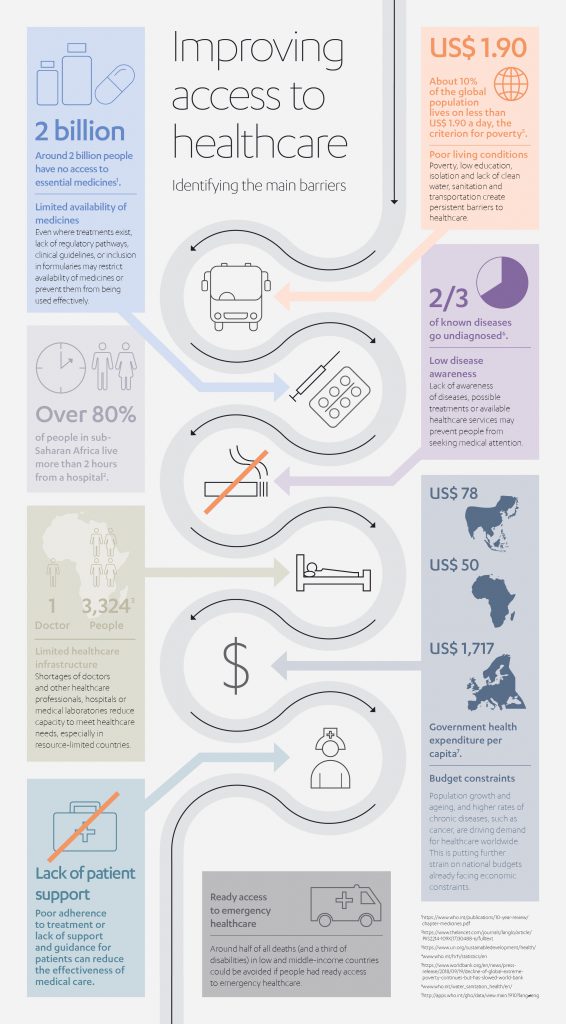 Non-communicable diseases like diabetes, cancer, heart and lung diseases, are increasingly prevalent, for example, accounting for 70% of deaths globally.[5] The increase is at least partly caused by factors such as poor diets, insufficient exercise, smoking, alcohol usage, and air pollution.
Non-communicable diseases like diabetes, cancer, heart and lung diseases, are increasingly prevalent, for example, accounting for 70% of deaths globally.[5] The increase is at least partly caused by factors such as poor diets, insufficient exercise, smoking, alcohol usage, and air pollution.
The ever-increasing urbanization of our communities is also adding to the pressure on health systems. The WHO estimates that by 2050, increasing urbanization in Africa and Asia will mean two-thirds of the global population will live in urban areas[6], where healthcare systems are often already creaking. Greater urbanization will also provide a fertile breeding ground for pathogens such as viruses, bacteria and parasites, and a potential bridgehead for zoonotic diseases which pass from animals to humans, to wreak havoc across our societies and economies.
Indeed, the National Institute of Health in the United States says that zoonotic diseases make up 60% of known infectious diseases and 75% of emerging contagions.
Examples include Ebola, bird flu (H5N1), SARS, MERS, COVID-19 and malaria, the world’s biggest killer, which affects 500 million people every year.[7]
There is no ‘silver bullet’ to improve access to healthcare for those who need it most.
It requires a combination of better investment, expertise, education, distribution and, above all, commitment, at every level.
The healing power of technology
Technology, too, can increasingly help to bridge some of the healthcare gaps that blight the lives of millions of people around the world.
In our Perspectives article on investing in health-tech, we explore how AI and machine learning technologies are being developed that can turn vast amounts of patient health data into detailed insights for treating, preventing and even predicting diseases.
Examples includes an AI-driven smartwatch that can measure temperature data and alert the wearer of infection before any symptoms are felt.[8] Or AI-driven apps that can predict alterations in glucose levels up to three hours in advance, or analyze tens of millions of data points to identify 300 alternative therapies for at least 12 types of cancer.[9]
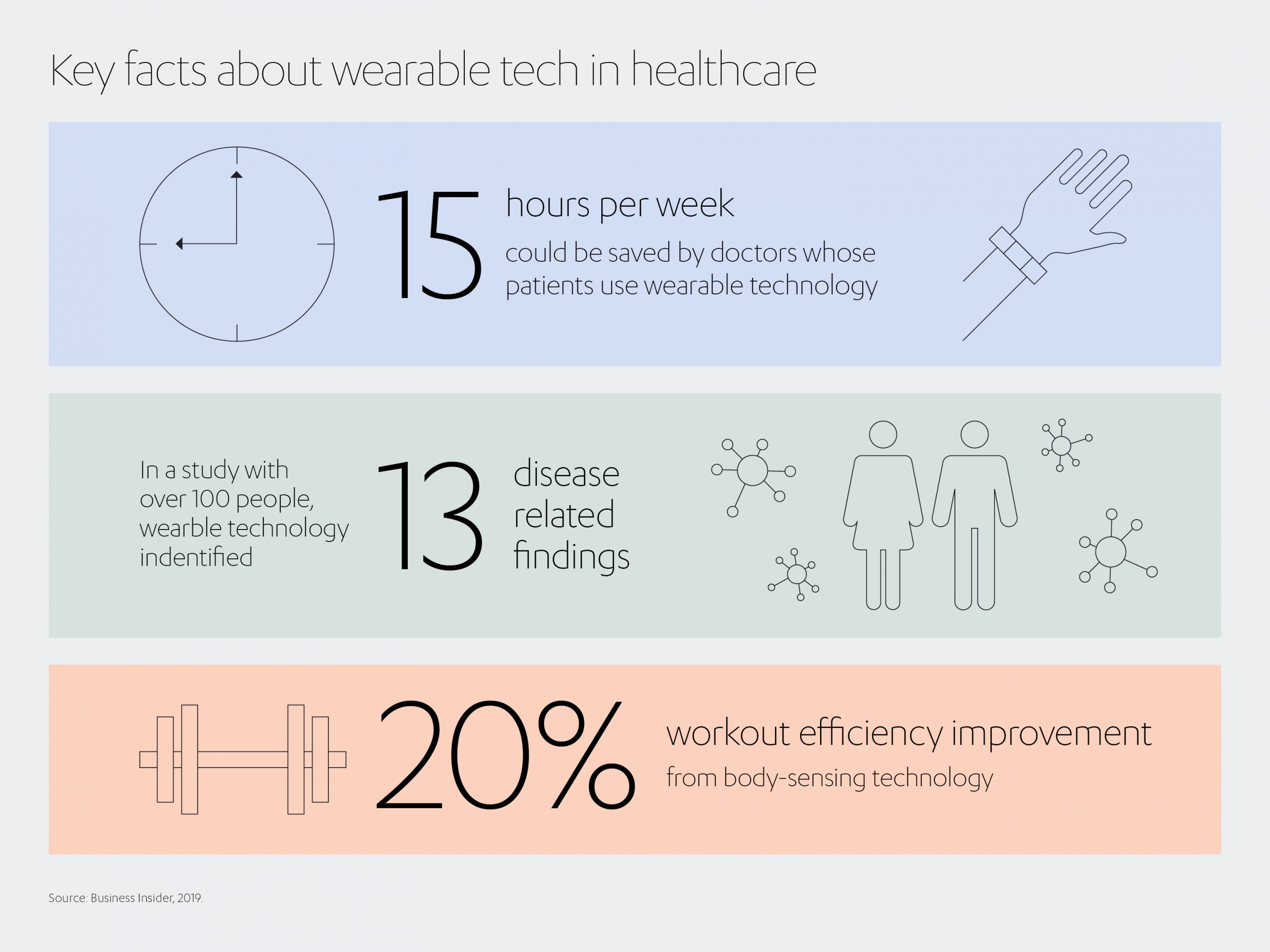
Another health tech focus is the development of smaller, more cost-effective devices to make diagnostics more accessible. One example is a handheld device that uses 9,000 sensors to perform ultrasound scans – a potential lifeline for the estimated two-thirds of the global population with no access to conventional ultrasound technology.
The possibilities of virtual health (also called ‘telemedicine’ or ‘mHealth’) are expanding rapidly, too, where patients and clinicians can have ‘virtual’ consultations in real-time, from almost any location.
This enables doctors and healthcare professionals to provide care and support at a time and location that is most convenient for the patient, particularly if there are physical challenges in terms of distance and access.
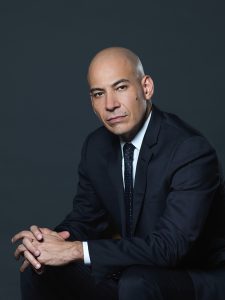
In theory, patients could book appointments, have consultations, order medicines, pay for services or seek health advice, even if hundreds of miles from their nearest hospitals or clinic.
“Improving access to healthcare is a complex puzzle requiring a deep understanding of both needs and solutions, including technology, infrastructure, distribution.
Addressing these issues has proved to be one of society’s biggest challenges.
But now more than ever, we have the technology and expertise to start making real progress. And I’m hugely excited by the opportunities ahead,” says Fady Jameel, Deputy President and Vice Chairman, Abdul Latif Jameel.
A trusted health partner
The Jameel family have long recognized the need to invest in healthcare as one of the key building blocks of the ‘infrastructure of life.’
It is over 25 years since the late founder of today’s diversified businesses and global family philanthropy established the Abdul Latif Jameel Hospital for Medical Rehabilitation in 1995, the first non-profit rehabilitation hospital in Saudi Arabia, providing comprehensive care for adults and children.
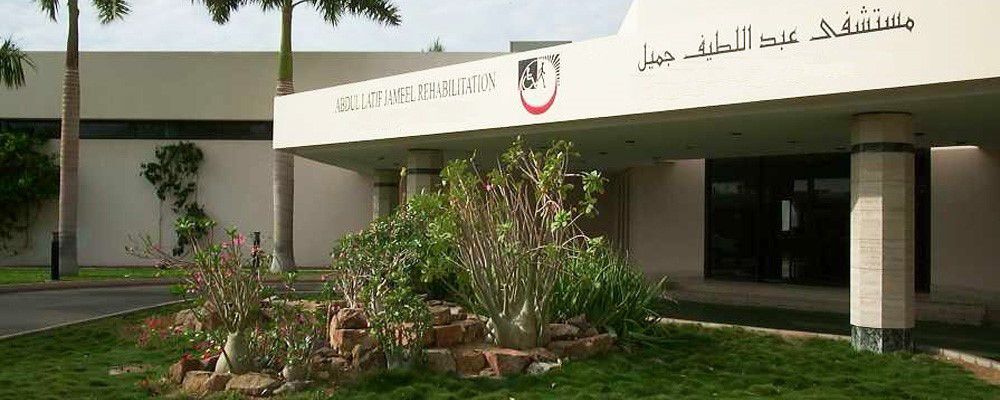
In the intervening period, the Jameel family’s global philanthropy, Community Jameel, has been helping to make healthcare more accessible and available through our research labs, the Jameel Institute at Imperial College London and the Jameel Clinic at MIT.
The Jameel Clinic (Abdul Latif Jameel Clinic for Machine Learning in Health, or J-Clinic) is at the forefront of research into healthcare technology, with a focus on using AI to model biological data across modalities such as imaging, text and genomics, and making new discoveries in machine learning, biology, chemistry and clinical sciences.
Similarly, the Jameel Institute (Abdul Latif Jameel Institute for Disease and Emergency Analytics, or J-IDEA) is using AI-based data analytics to identify, map and prioritize preventable communicable disease risk and public health worldwide.
We recognize, however, that to help improve healthcare for all, it is not enough to invest in R&D to develop new innovations and technologies. To make a real, sustainable improvement means getting the technology out of the labs and into the field.
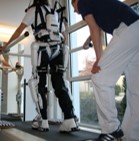 This recognition has already driven a number of partnerships with leading health tech companies across the globe. In 2017, we partnered with Cyberdyne, an innovative Japanese health tech company that specializes in spinal injury rehabilitation using robotic exoskeletons, to bring this cutting edge technology to Saudi Arabia.
This recognition has already driven a number of partnerships with leading health tech companies across the globe. In 2017, we partnered with Cyberdyne, an innovative Japanese health tech company that specializes in spinal injury rehabilitation using robotic exoskeletons, to bring this cutting edge technology to Saudi Arabia.
We extended the partnership in 2019, to roll out Cyberdyne’s Hybrid Assistive Limb (HAL®) technology across the Gulf region and establish the Abdul Latif Jameel Hospital as a regional training center.
We established a similar partnership with Cellspect, another Japanese health tech pioneer, to provide fast, affordable blood testing in developing countries. Cellspect’s point of care testing device currently checks sugar metabolism, lipid and liver function in just a few minutes.
Conscious of the challenges many innovators face in getting their products to market, we have also partnered with the Japanese Organization for Medical Device Development (JOMDD), to help scientists, engineers, clinicians and entrepreneurs push forward new devices and technology.

The next stage in our mission to strengthen the availability and accessibility of good quality healthcare across the globe is the establishment of Abdul Latif Jameel Health.
Led by CEO Akram Bouchenaki, formerly an executive director at a major healthcare giant, Abdul Latif Jameel Health aims to accelerate access to modern medical care, while addressing unmet medical needs in developing markets around the world. To achieve this, it invests in projects, partners and products that strengthen the scope and quality of healthcare available to those in need.
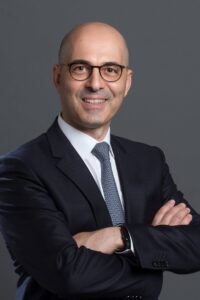
Chief Executive Officer, Abdul Latif Jameel Health
“Abdul Latif Jameel has proven over 75 years its ability to build partnerships at all levels across multiple industries, to understand different markets and, crucially, to deliver what those different markets need to meet local expectations. We want to replicate this model in the healthcare industry,” explains Akram in a Perspectives article on Abdul Latif Jameel Health and its mission to improve access to healthcare.
The healthcare market is at an exciting yet critical junction. The boundaries of what is possible are expanding ever outwards, as we seek to make high quality healthcare universally accessible.
Momentum and continued innovation will be key, along with new channels of finance from investors with a long-term commitment and a holistic vision. A vision that sees success not only in terms of financial returns, but also humanitarian outcomes. Achieving this goal will not be easy, but millions of lives depend on our success.
[1] https://news.un.org/en/story/2020/10/1074832
[2] https://www.who.int/hdp/en/
[3] https://www.worldbank.org/en/news/press-release/2018/09/19/decline-of-global-extreme-poverty-continues-but-has-slowed-world-bank
[4] https://blogs.worldbank.org/opendata/impact-covid-19-coronavirus-global-poverty-why-sub-saharan-africa-might-be-region-hardest
[5] https://www.who.int/news-room/feature-stories/ten-threats-to-global-health-in-2019
[6] https://cities-spotlight.who.int/
[7] https://www.who.int/whr/1996/media_centre/executive_summary1/en/index9.html
[8] https://www.jclinic.mit.edu/post/ml-for-covid-19-can-ai-give-you-an-alert-indicating-a-viral-infection-before-you-feel-symptoms
[9] https://www.healthcareglobal.com/technology/four-ways-which-watson-transforming-healthcare-sector





 1x
1x

 Added to press kit
Added to press kit


